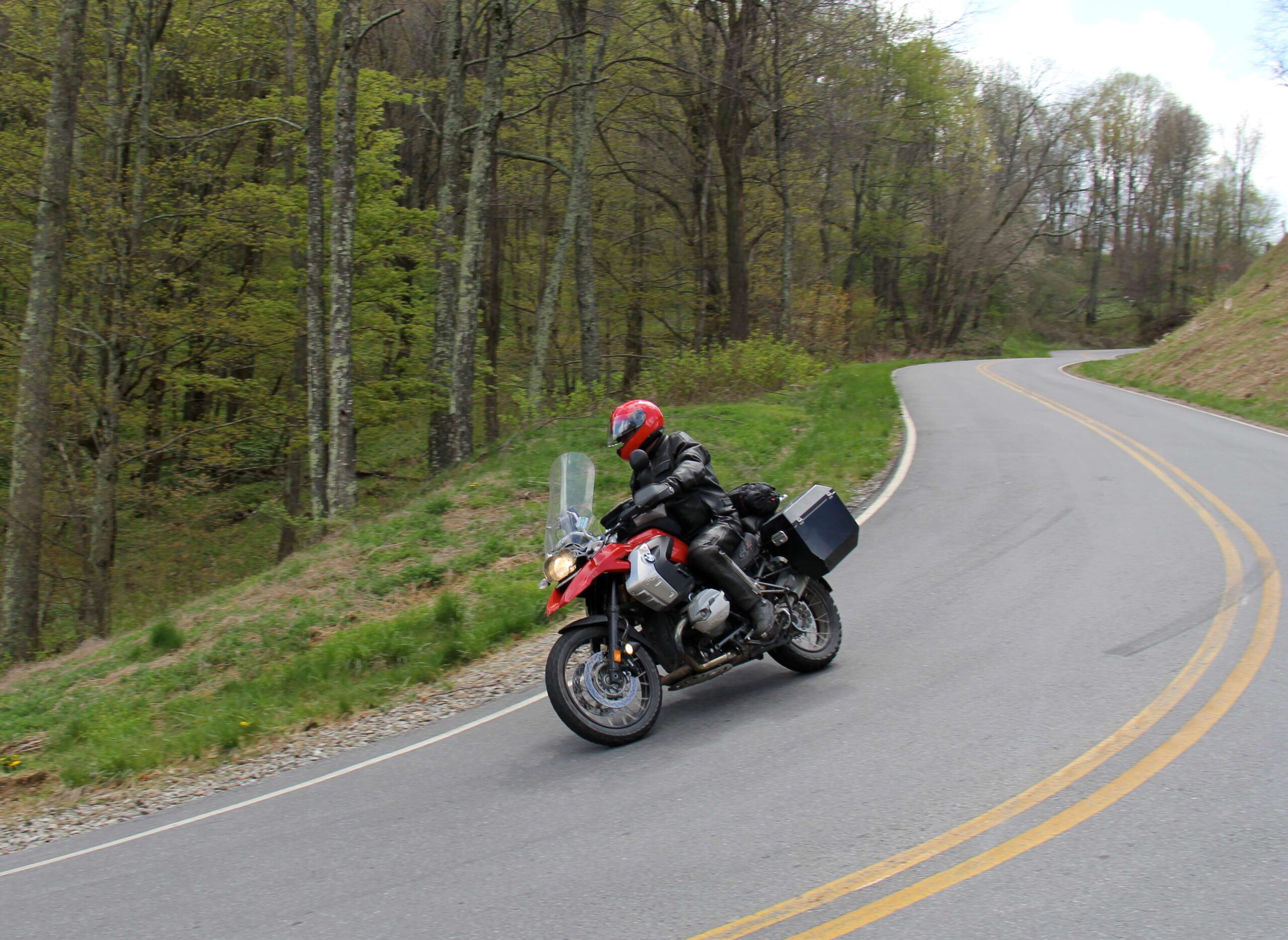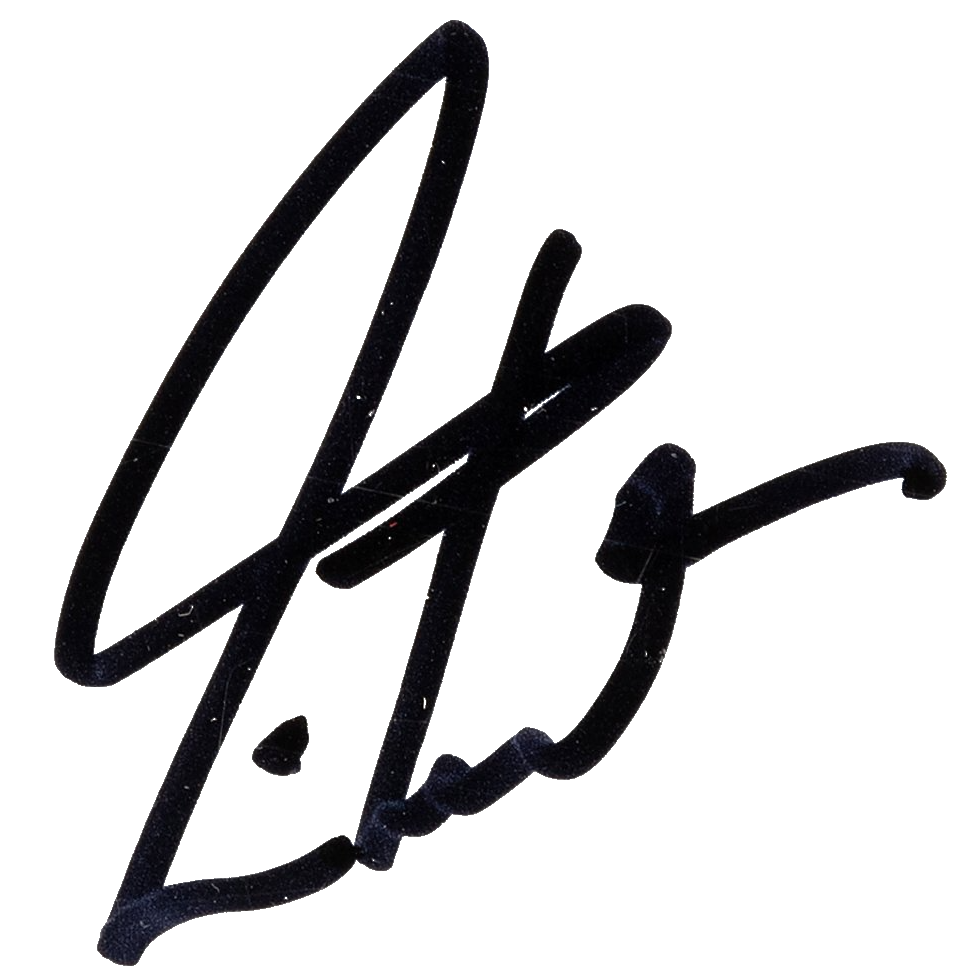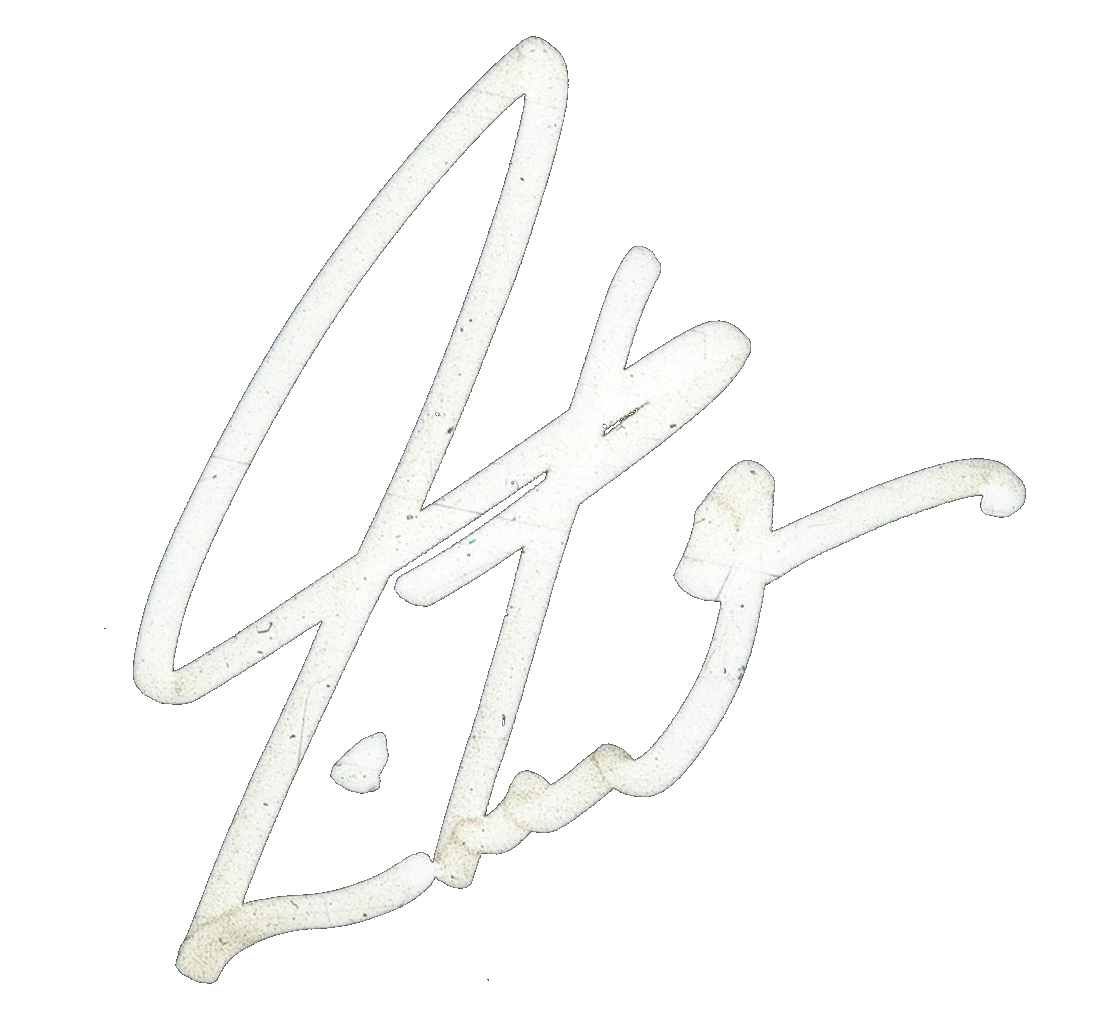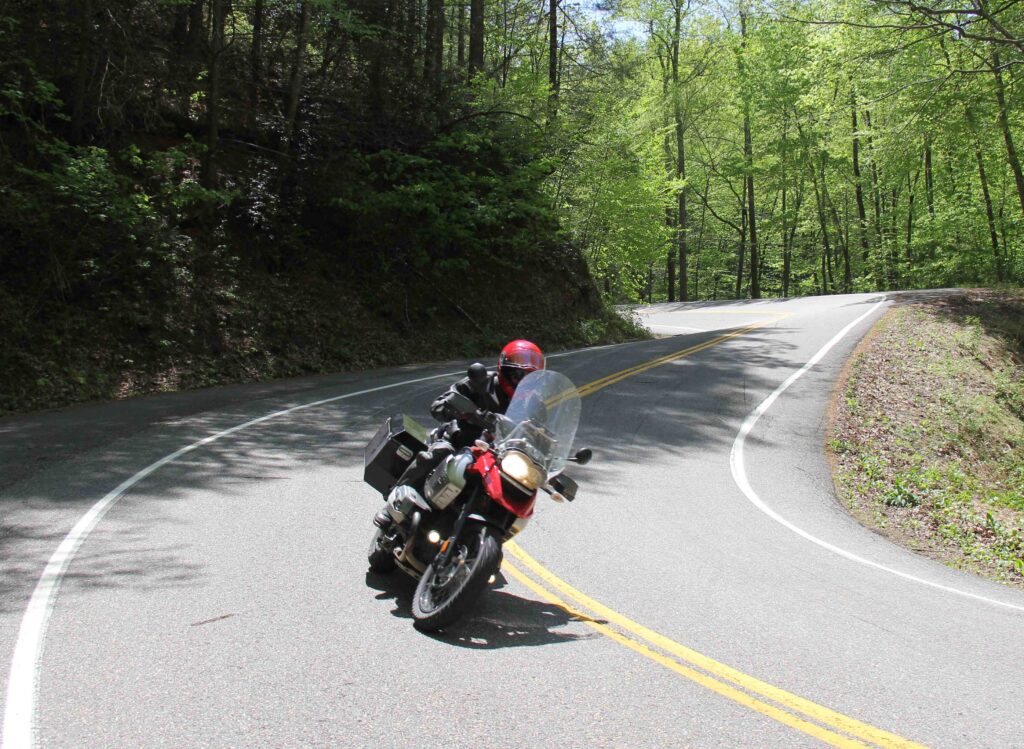
The phrase was coined a couple of hundred years ago by an English sportswriter, referring to . . . boxing.
This reporter has never sensed anything “sweet” or “scientific” about a couple of guys punching each other’s lights out, but some people feel it. Among the many superb non-fiction writers to have appeared serially in The New Yorker over the years (Joseph Mitchell, Dorothy Parker, Truman Capote, John McPhee, etc.), A.J. Liebling revived the theme for a series of articles about boxing in the 1930s and ’40s that were later collected in a book titled The Sweet Science.
Personally, I can think of human activities that seem infinitely sweeter than pugilistics (though the Greek word is fun — pygmachia — but perhaps not as fun as eros), and others that are more truly scientific. Even, dare I say, more artful. And without causing facial mutilation and irreversible brain damage.
One late-April day on my motorcycle, railing through the forested mountains of North Carolina on a relentless sequence of curves in every possible geometry, I thought, “This is the sweet science.”
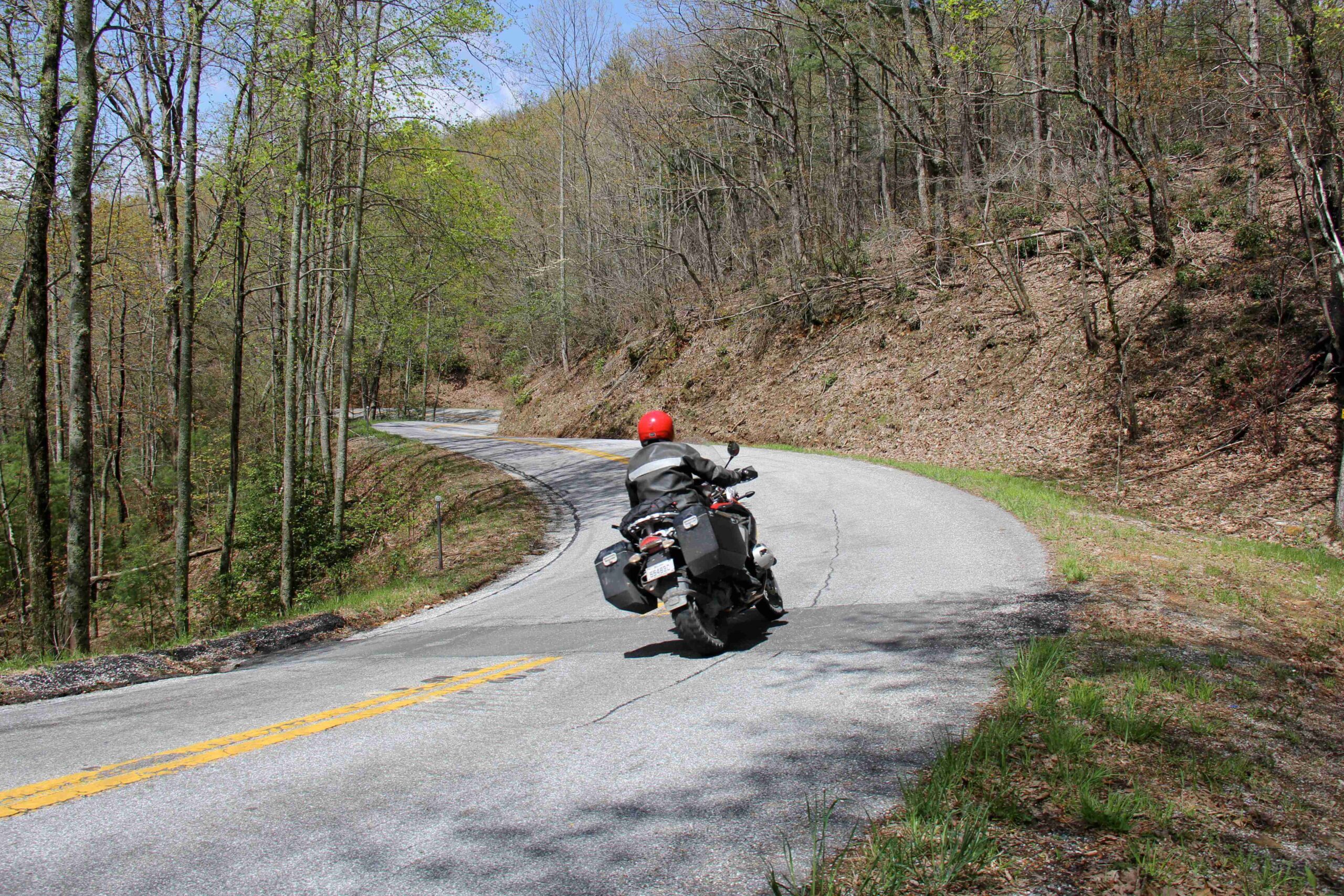
Threading a series of corners like this with sporting intent (i.e., swiftly and smoothly), a great many decisions are made and executed. You choose your entry speed and gear early, get the bike settled before you bank it in, and keep to the outside of the lane as long as you can, to see through the corner as far as possible and into the next one — and be seen by any oncoming traffic. Turn in early toward the apex, always allowing a little leeway to adjust your line, speed, or banking angle to dodge a pothole, a spray of gravel, an oncoming vehicle wandering into your lane, or — on blind rural corners — a tractor or a cow. With everything in balance, once you’re committed to the turn and in a steady state, a few degrees more or less throttle should be all the steering you need. To adjust the lean angle is to adjust the radius of the arc.
Exiting the turn, you run out wide again, head turned to look through the next corner (a counterintuitive technique that has to be learned — “Don’t look where you are, look where you’re going”).

Photo by Michael Mosbach
The science of physics rules everything here, perhaps most of all where the rubber meets the road — the so-called coefficient of friction (COF, or µ) where your tires roll on pavement, gravel, dirt, wet leaves, manure, or puddles. On a motorcycle, you experience no “lateral Gs” — the rider always feels ninety degrees of gravitational pull, never thrown from side to side as one would be in a car.
However, the corollary is that a motorcycle has a very small contact patch — virtually two hand-prints gripping the road — and it is a “single-track” vehicle. It has been said that, “A motorcycle is so stupid it can’t even stand up by itself.” That is a mantra to be kept in mind at all times. (My friend Rick Foster adds another groaner: “A motorcycle can’t stand up by itself — because it’s ‘two-tired.’”)
At its best, the rider’s rhythm through a series of corners is like a slalom course on skis, or a hot lap on a racetrack — linking the turns gracefully, smoothly, and safely. No doubt the experience is sharpened by constant awareness of the consequences.
Getting it right is very satisfying; getting it wrong could be very painful.
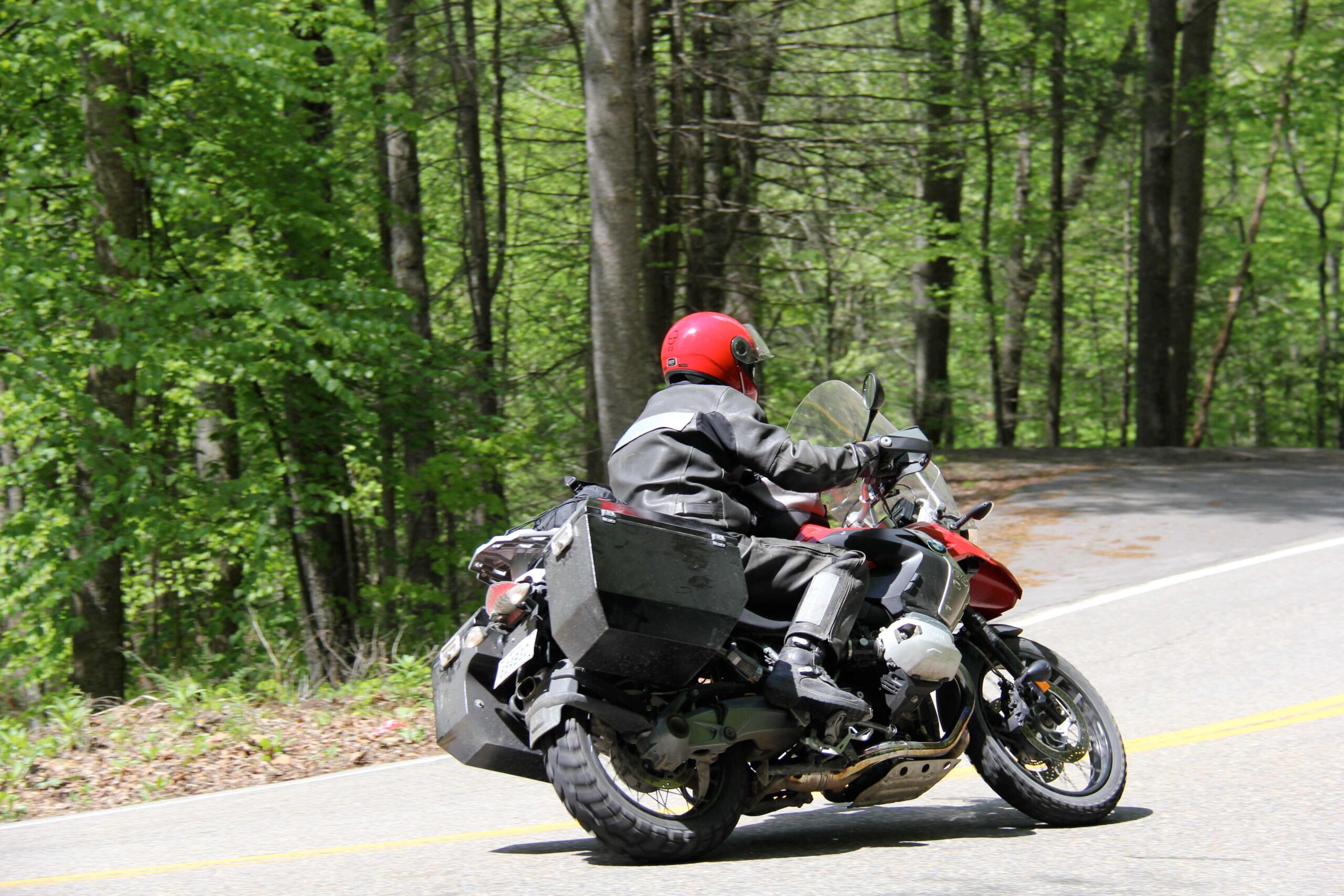
Tour itineraries vary almost infinitely in the way showdates are connected and ordered — and thus in the areas between I am able to explore on days off. The early dates on this run of the tour happened to fall such that I was able to route us through North Carolina on several consecutive days off, commuting among shows in Orlando, Nashville, Raleigh, and Virginia Beach. Thus, by lucky happenstance, North Carolina became my “new discovery.” (A few tours ago I told Geddy that my latest discovery was Pennsylvania, and he said, “I’m pretty sure it’s already been discovered — people live there and that.”)
Previously I have rhapsodized about riding in other East Coast states such as Virginia, West Virginia, and Upstate New York, but this time the mountain backroads of North Carolina greatly impressed me. They gave Michael and me a rich and varied playground — I mean scientific laboratory.
One theme I have been pursuing in our photo setups is seeing how many corners we can get into one scene. Extreme settings, like a series of steep switchbacks in the Alps or Andes (see “The Power of Magical Thinking”) make it easy, but “regular” mountain roads are more of a challenge.
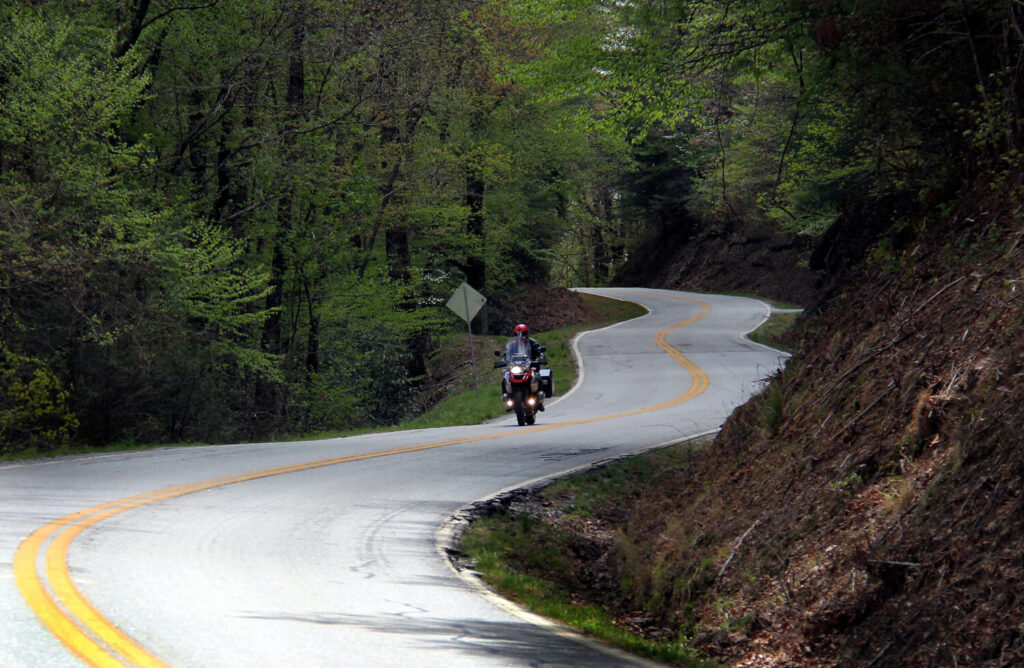
This photo of one of those North Carolina byways made our highest score so far — five curves in one shot. It will be hard to beat — not just numerically, but for the road’s lack of shoulders, powerlines, guardrails, or other unsightly distractions. As I ride along with an eye out for photo settings, countless possibilities are rejected simply for having ugly powerlines in them — a dealbreaker for me. (Yes, I know there are easy ways to “fix it in the mix,” as musicians used to say, and that’s fine for “decorative” photos. But not for “scientific” ones. We have our standards.)
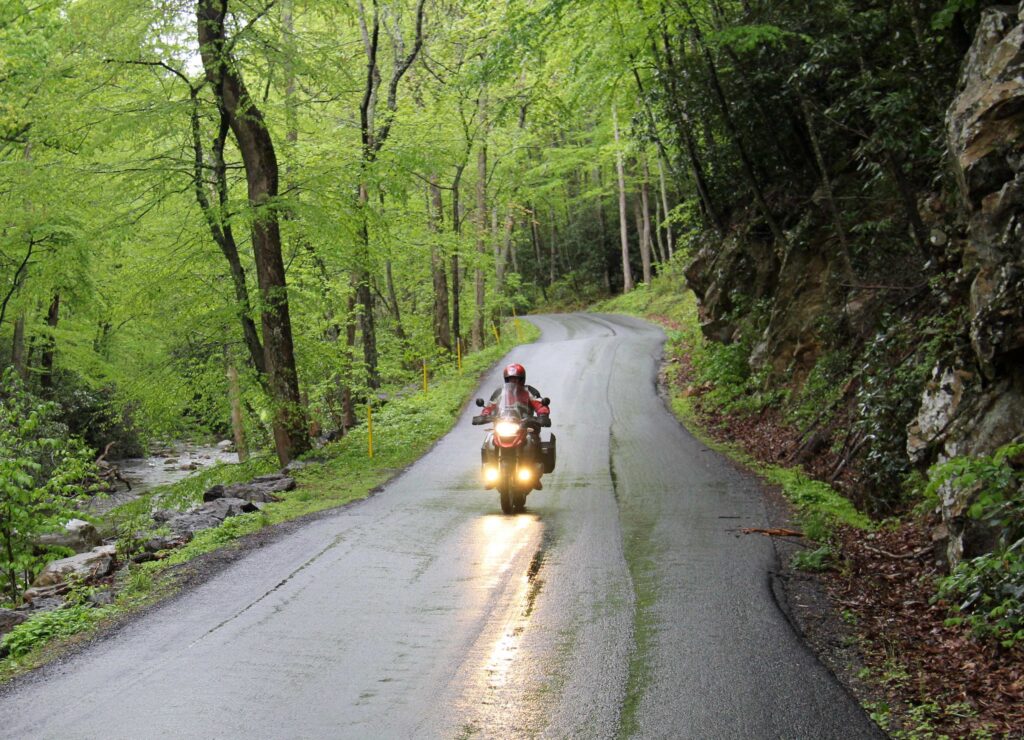
Photo by Michael Mosbach
Another science of paramount importance to a motorcyclist is meteorology — the weather. (As a “weather enthusiast,” I confess that seems like a sweet science, too.)
Unlike passengers in a car, a motorcycle rider is exposed to every degree of temperature, every drop of precipitation, and every unsettling crosswind. I have noted before that on the motorcycle, I can feel a rise or fall of only two degrees, and of course the difference between riding on a wet or dry road surface changes everything. Temperature and moisture have a direct effect not only on one’s comfort level, but on that all-important physical relationship with the road.
Traction, control, margin of error, not falling down.
Then there is the “vision” thing, to see and be seen. Clearly (or not), the weather has much to do with that, as well . . .
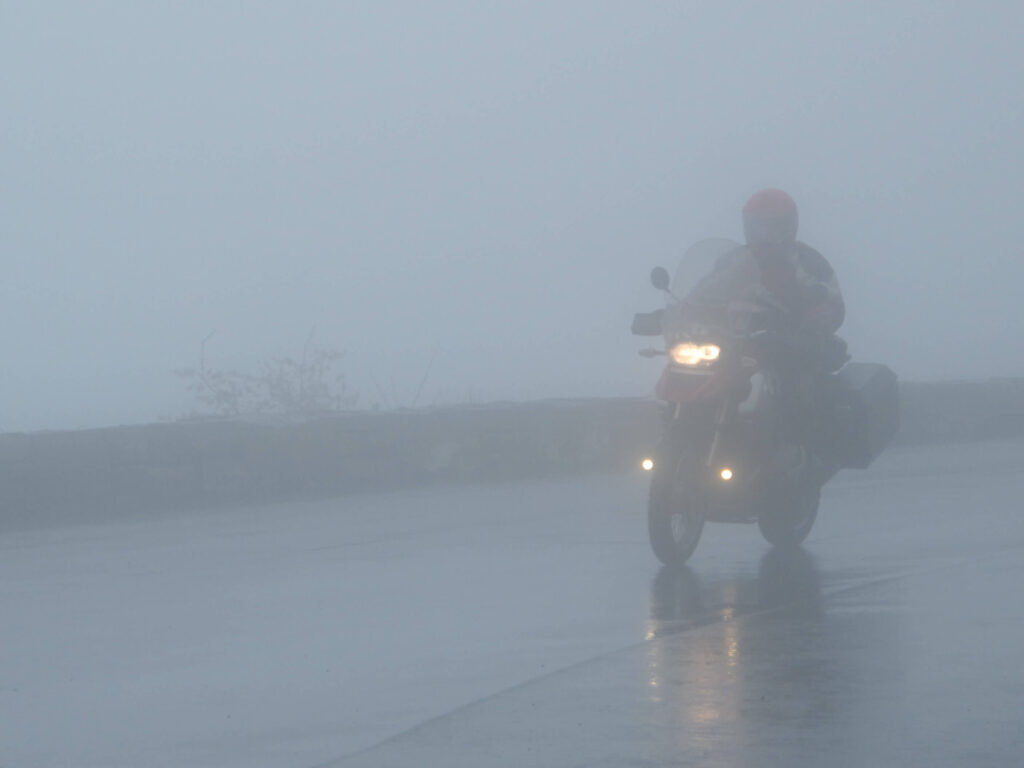
Photo by Michael Mosbach
This first leg of the second part of the Clockwork Angels Tour, in spring, 2013, had been designed to be an East-Coast run. However, late last year the band was informed that our presence might be required at some little awards show on the West Coast, in mid-April.
At the time, the odds of us being inducted into the Rock and Roll Hall of Fame seemed unlikely-to-absurd, after something like fourteen years of rejection, but apparently we were “on the ballot.” So manager Ray insisted we had to factor it into our plans, and adjustments had to be made.
One change that suited me was that instead of band rehearsals taking place in Toronto, as usual, they would be in Los Angeles. So I would have a few extra weeks at home. In December I got a message from Ray asking me to call him. Fearing bad news (we get our share of that, like anyone else), I called him with a little trepidation. When Ray told me we were “in,” it took a while to process the mix of feelings: disbelief, delight, and a little more trepidation. There would be
. . . challenges . . .
(See “Where Words Fail, Music Speaks.”)
Following my own pre-tour preparations at the local Y, and at Drum Channel’s studio (two-and-a-half weeks of playing along with the recorded versions of the show, tuning up my technique and stamina), I joined the Guys at Work (Alex, Geddy, and our crew) at a warehouse in the San Fernando Valley.
That was when things started to become surreal.
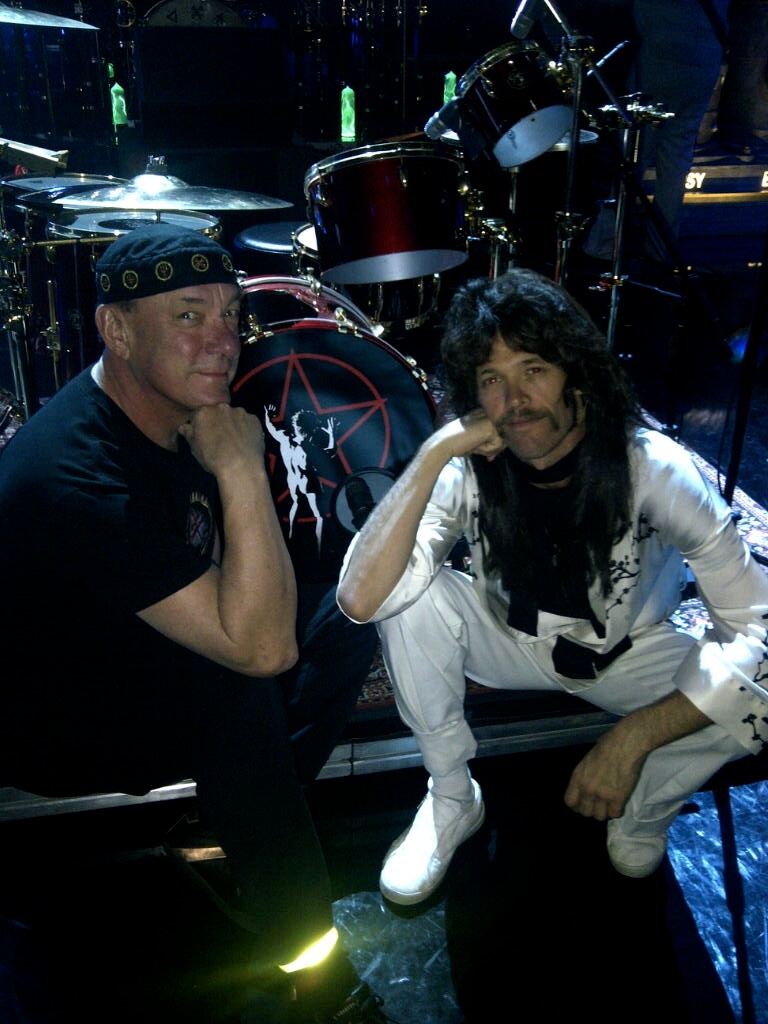
(or 2013 Meets “2112”)
Photo by Craig M. Renwick
On our last day in the warehouse, we were joined by Dave Grohl and Taylor Hawkins from the Foo Fighters, and our mutual coproducer Nick “Booujzhe” Raskulinecz. They wanted to rehearse their spoof of us from . . . thirty-six years ago.
By now, the televised show in all its glory (I have faith it will retain the essence of what it was like to experience the real-time event — truly larger than life) will be widely shared. The performances, the speeches, the humor, and the overwhelming gathering of the Great and the Good are part of some kind of history now. However, the inner experience of living all that was something else again. Not larger than life, but exactly life-size.
The only way to portray even the ghost of what that few days felt like from the inside might be to jump ahead to when it was over — to a “reflective” moment.
The day following the event, I was able to bring my family with me to Austin, Texas, for a few days, for two production rehearsals and a day off before the first show there. Late on the night of the travel day, I found a moment of peace and reflection, and the next day I started writing a report to a group of friends called the “Breakfast Club for Cuties.” Brutus came up with that name for an informal email circle of four scattered Canadians (Icechuckers) — Brutus in Cowfart, Alberta, me in Westside L.A., friend Craiggie in Pasadena, and brother Danny in Vancouver, British Columbia.
All early risers, and in similar time zones, we gradually fell into the habit of exchanging notes early in the day — jokes, comments, thoughts, insults — almost daily for a while. They tapered off when one of the members had to go away on tour, but we still continued to communicate from time to time, as touring life allowed (for me, more likely late at night on the bus after a show than early in the morning).
After that night’s solitary reflections, I played the entire show the following night, and arrived home on my motorcycle feeling stimulated by both the performance and the dark ride home.
(I rarely choose to ride at night, especially in a region with so many deer, but it is certainly exciting. A milder version of Sir Winston Churchill’s great quote, “Nothing in life is so exhilarating as to be shot at without result.”)
So, tired and sore and yet all abuzz, I lounged outside on the balcony of the family condo with a large glass of the Macallan, and continued trying to put down some reflections to share with the Q-Tees™.

Subject: Aftermath
Austin, TX
Gentlemen:
Some story notes I will share with my fellow Cuties.
Last night, I was sitting out late on the balcony of our family condo on the shore of Lake Travis, near Austin. B [Brutus] will remember it as a dam-widened stretch of the Colorado River (the Texas one, not the Grand Canyon one) near where the Pedernales (much more “Tex-Mex” kind of name) flows in.
For the flight here with the Guys at Work on their Falcon (nice — like the one B ’n’ me shared with them in Germany one time), with Carrie and Olivia, I dressed in Cowgirl Olivia’s honor — my “cowboy clothes.” Hat, shirt, and the boots I bought here in Austin last December (my first cowboy boots EVER!).
So, settlin’ back on the comfy outdoor sofa, I had my boots up on the table. The night was a little chilly, so I had a blanket around my shoulders.
From what must have been a bar at the marina across the water, a pretty good blues-rock band was playing (Friday night).
So, I was settin’ there, looking out at the dark water dotted with pretty colored lights, digging the band’s groove, and treating myself to a little extra rations of The Macallan. It was then I finally had a chance to reflect a little on the past night.
That thought flashed into my head, thinking — that was only LAST NIGHT!
The contrast between that frenetic state of mind and my present peaceful equilibrium was a complete polarity.
It’s going to take a week or so of reflection to sift through that entire overwhelming experience — just processing the data, as it were, slowing down the replay to remember moments in isolation and string them together into some kind of . . . narrative. Even my own interior narrative.
However, for me, the all-important part of last night’s reflections was the mood that colored all of my scattered memories — bathed in a glow of satisfaction.
Not for the honor and glory — but basically just because I had “done my job” properly. The key elements of that satisfaction were simple: I had spoken and played well.
Not only on our songs and the “Crossroads” jam, but even laying down a (hopefully) funky groove behind a pair of full-on master rappers. (Michael witnessed the “rehearsal” for that, just an hour before showtime, and he wished he could have filmed it. Geddy and I met in a backstage room with Chuck D from Public Enemy (“911 is a Joke in Your Town”) and the “DMC” of Run-DMC. They described the rhythmic feel, and where we should come in, and on what line we should stop. We nodded.)
There was also the star- (guitar-) studded “Crossroads” jam, for which I was also responsible for laying down the foundation of tempo and feel. So . . . my state of mind leading up to “all that” might best be expressed by “yikes!”
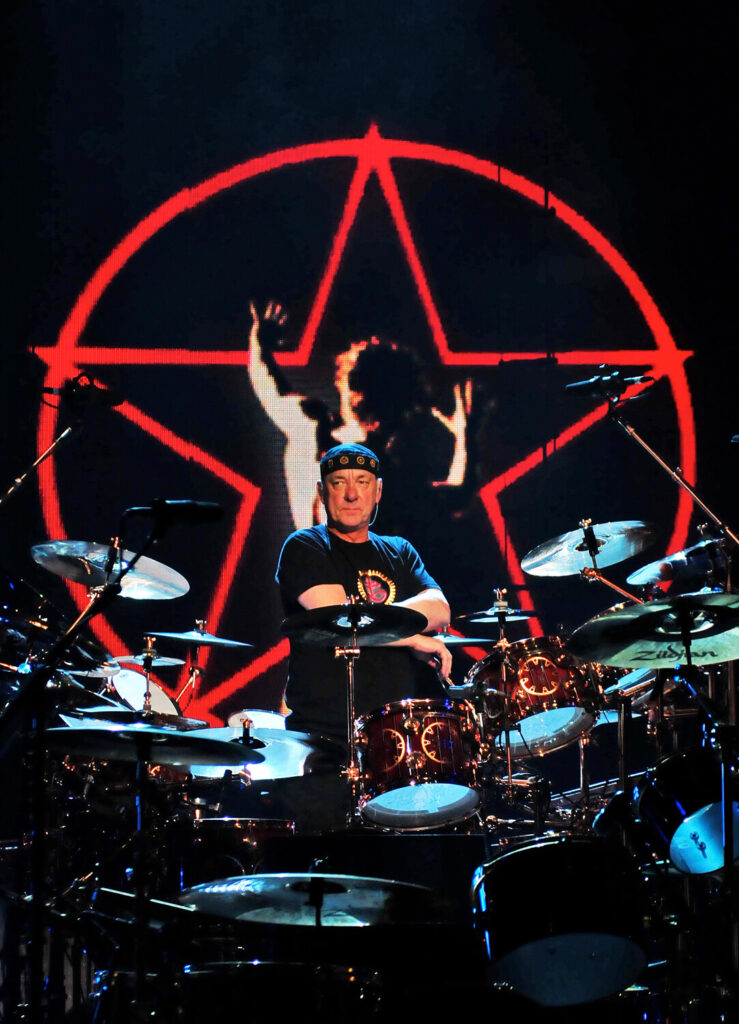
Photo by Craig M. Renwick
Just moments after it was over, as Geddy and I met in the quick-change tent at stage left (just like Madonna!), he said, “We laid it DOWN.”
And, shockingly, we did.
During the previous night’s rehearsal (our hip-hop brethren did not attend), after the “Crossroads” jam (do you believe that lineup of guitarists? Whoa!), one of the “presiding geniuses,” some rumpled-looking guy in a suit and tie, came up to me onstage and suggested that the tempo should be slower. I knew I was playing it the way we had recorded it, modeled on Cream’s version, but — I am a professional.
So I pulled it back a notch, and we played it again. It felt fine to me either way, but the boge [our slang for “square”] said it felt heavier and better for the soloists to breathe. I could see that. Then he suggested even a notch slower yet, and I said, “Okay.” There was no time to rehearse that, but I fingered out [how Brutus always says “figured”] a proper “feel” for a slightly slower tempo in my brain (’cause it ain’t just math, eh?). I also asked the geniuses to pass around to all the other players that I would be playing it slower.
(If nothing else, I wanted them to know it was on purpose!)
Well . . . Geddy wrote back in response to that report with, “That boge was Jann Wenner!” [Founder of Rolling Stone, and co-director of the Hall of Fame.]
Ha ha! — Perfect!
The world’s most powerful Rush-hater, rumored to have personally kept us out of the HOF all these years!
[Taylor Hawkins told me later that at that moment he had to walk away so he wouldn’t hit him — and when I wrote about it to another mutual friend and fellow drummer, Stewart Copeland, he wrote back that he wished he had been there, so he could head-butt the guy!
Nice to have the support of my drum-brothers, but I didn’t see it as an insult, but a challenge. I am Canadian, and “We aim to please.”
The only problem was . . . doing it.]
But on the night, once again, I delivered just what I had wanted to, nailing exactly the tempo I imagined and holding it there — playing by the K.I.S.S. technique [“Keep It Simple Stupid”] — with what felt to me like a good solid groove.

Photo by Craig M. Renwick
The speech thing also got complicated. We had planned to be brief and improvised, with some remarks about family, business people, and fans — but then were told “Rash” needed time between the induction and their performance to change into their . . . kimonos . . .
They needed at least five minutes — yikes again!
So . . . I made some “point form” notes. Then heard that we couldn’t use the teleprompter for OUR speeches. (I loves me some teleprompter.) All the presenters used it, and even the rappers, but I guess the geniuses had some idea about keeping those of the inductees “natural.”
(And oh — wait until you guys up Nord see the Flavor Flav show. Oh my, eh Craiggie?)
So I wrote out my speech in full, and printed it out LARGE — hoping I wouldn’t have to use my glasses.
Then midway through the show, we heard that our speeches would be on the teleprompter. So . . . good.
That worked!
Praise Allah, it all worked.
[I began my speech with an improvised remark about how for years we had been saying this was no big deal — then followed with a turn-of-phrase typical of my friend Matt Scannell, “Turns out, it kind of IS!”]
Now — back to business-as-usual for us Rushians. First full-production rehearsal tonight, then again tomorrow night, then a day off, then the first show.
Then some more shows . . .
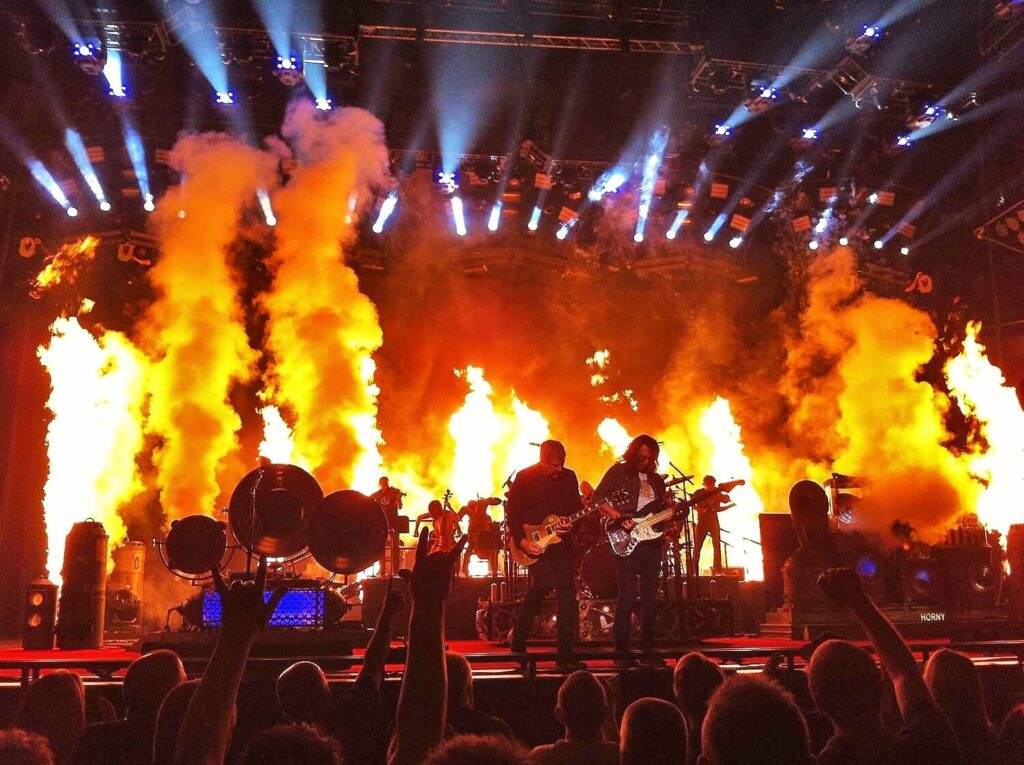
To me, this image is more special than it appears, because it is a true fan’s-eye view, a random moment from a random place in the crowd. Typically, it was captured on one of the thousands of cellphone cameras we see out there every night. (Some people seem to spend half the show looking through, or at, their handheld devices.) Matt Scannell asked me to arrange a pair of tickets for a friend of his at one of our shows, and later, the friend sent Matt his thanks, and this photo, taken by his guest. I like to leave it anonymous, as a symbol of something that seems important. I am always playing for somebody named “A. Fan.” Perhaps an ideal listener I consider The Fan.
It also captures a moment I wrote about in a previous story — the cello players hunched over their instruments to protect them from the heat of the pyrotechnics. (I told Jacob he is rocking a Chuck Berry pose.)
The show this time out is the same musically and visually that we performed last fall — thirty-five times — so you could say we “have it down.” While that’s true, the performance is never easy, and because of that, it remains rewarding to get it right — to feel that I’m getting the sweet science of drumming smooth and strong.
And even after all those shows, before starting certain especially complicated songs, like “Grand Designs” or “Headlong Flight,” for example, or before one of my solo spots, I pause to engage a “higher gear” of concentration. Some songs I can just count in and “launch,” but those examples demand just a little more attention to detail.
Some roads are like that, too. Sometimes you have a relaxed cruise, an easy flow down a straight open road. In the mountain roads of North Carolina, you need a little more attention to detail, a higher gear of concentration . . .
